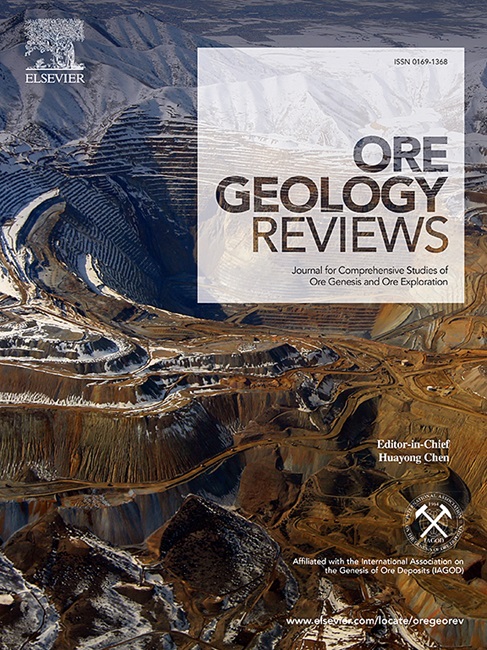Fertile Cu-Mo magmatism in southern Jinshajiang-Ailaoshan Metallogenic belt, Western Yunnan: Constraints from the Chang’anchong deposit
IF 3.2
2区 地球科学
Q1 GEOLOGY
引用次数: 0
Abstract
Compared with the calc-alkaline rocks of subduction-related porphyry deposits, the genesis of the shoshonitic felsic intrusions associated with collision-related porphyry deposits in that Jinshajiang-Ailaoshan Metallogenic Belt remains controversial. Chang’anchong Cu–Mo orebodies from this belt occur mostly in contact skarn and internal alteration zones between quartz monzonite and limestone, and provide an ideal case for the abovementioned controversy. Zircon U–Pb dating and previous molybdenite Re–Os age confirm the coeval formation of the Chang’anchong magmatism and mineralization at ∼35.2 Ma. The ore-related quartz monzonite is identified as shoshonitic I-type granite, characterized by low-K hornblende occurrences, and moderate SiO2 (65.46 ∼ 69.37 %), high K2O (4.96 ∼ 5.82 %), and low A/CNK (0.96 ∼ 1.01). Furthermore, its geochemical profile enriched LILEs and LREEs, depleted HFSEs and HREEs, with high Sr/Y ratios (47 ∼ 65), moderate Nb/Ta ratios (10.8 ∼ 12.4) and Mg# of 48 ∼ 55 distinguishes it from adkite or adakite-like rocks but previously defined shoshonitic felsic intrusion. The quartz monzonite is characterized by low initial 87Sr/86Sr ratios (0.70713 ∼ 0.70729), εNd(t) values (−5.7 ∼ −5.5) and εHf(t) values (−3.4 ∼ −0.3) with TDM2(Nd) of 1.29 ∼ 1.31 Ga and TDM2(Hf) of 1.14 ∼ 1.34 Ga, suggesting a magma source derived from thickened lower-crust mixted with Neoproterozoic subduction-contaminated mantle-derived materials. The high LILEs contents, log(fO2) values, thermometry and Sr/Y values suggest that Chang’anchong quartz monzonite formed under conditions of water-rich, moderate-high temperature (∼800 °C) and oxygen fugacity within the garnet stability field for porphyry Cu–Mo mineralization. Together with previous research on regional tectono-magmatic activities, we infer that Chang’anchong shoshonitic granite was generated in the transtensional tectonic setting triggered by asthenosphere upwelling during the late-collision of the India and Eurasian plates, creating favorable conditions for porphyry mineralization in the Jinshajiang-Ailaoshan Metallogenic Belt.

求助全文
约1分钟内获得全文
求助全文
来源期刊

Ore Geology Reviews
地学-地质学
CiteScore
6.50
自引率
27.30%
发文量
546
审稿时长
22.9 weeks
期刊介绍:
Ore Geology Reviews aims to familiarize all earth scientists with recent advances in a number of interconnected disciplines related to the study of, and search for, ore deposits. The reviews range from brief to longer contributions, but the journal preferentially publishes manuscripts that fill the niche between the commonly shorter journal articles and the comprehensive book coverages, and thus has a special appeal to many authors and readers.
 求助内容:
求助内容: 应助结果提醒方式:
应助结果提醒方式:


